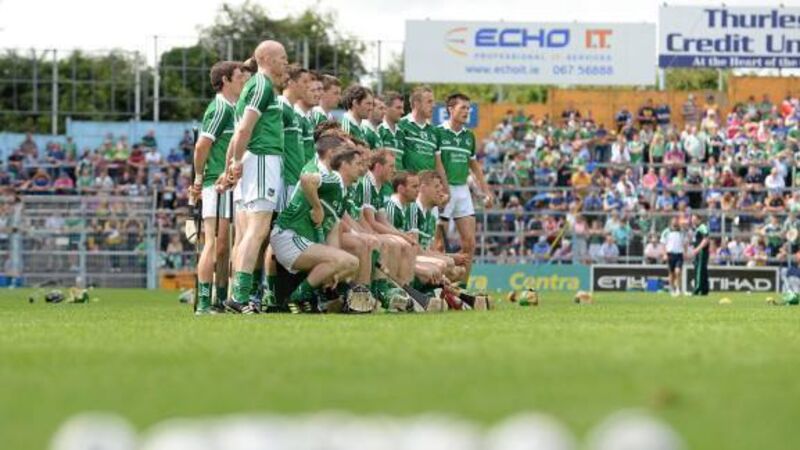Radical reform is needed for Gaelic football to thrive

A few years ago at Cork training Denis Walsh set up an exercise for us. The backs were to defend against the forwards. It was a conditioned game. Only goals could be scored. The forwards would start in possession around midfield.
So I called the six backs in and said ‘okay lads, we line up with a wall of four players across in front of me and then two players in front of them. Nothing passes. Stay disciplined. If somebody gets pulled out of the line of four somebody else drops back to take their place immediately. Stay fluid. We always have bodies in front of the ball. Just suffocate them.’ The drill didn’t work out as Denis had planned. An exercise designed to improve the capacity of our forwards to make and take goal chances had turned into a look at the design flaws built into modern Gaelic football.
I’m not a hurling snob (I am, but let’s pretend for a few minutes) and I am one of the weird minority of neutral people who found the 2011 All-Ireland football semi-final between Donegal and Dublin interesting to watch. It was an extraordinarily tactical game with two very bright men on the sideline. Pat Gilroy and Jimmy McGuinness had done what very few managers really do. They had studied the resources they had and each had constructed the best team possible from those resources. That afternoon they had to think non-stop for 70 minutes to come up with a way to beat the team put together by the other man. I found it fascinating to watch.
That’s the first point to be made about football and hurling. Management has to have the ability to think. I’m only half joking when I say, in football especially, a manager should have just one year in charge of a county team. The previous year he shall be the manager elect and he shall be locked away on a remote island somewhere, an island with no contact to media (Armagh maybe). That way he won’t be able to spend his first winter in the job slavishly copying the style and tactics of the previous year’s All-Ireland winning team, regardless of the sort of players he has to do the job. Give him just the one year in charge then and he might, out of vanity, want to make his mark and win the whole thing rather than securing his post for the following year by playing a double sweeper system and cutting down on the margin of eventual defeat.
Like all Cork people I admire Dublin greatly and I think Dublin people are great to stay living up there in the favelas and townships. Fair play to them. You have to say as well that there is no point in other counties begrudging Dublin footballers because they have got their system right and are producing so many top grade footballers at the moment. The only option is to do the same and match them. Just as for the last decade or so there was no point in moaning about Kilkenny having their systems right in hurling. The idea is not to drag them back but to make yourself better.
What has to be conceded is that developments in the game have tended to favour the better resourced counties in the last few years. We have five subs now instead of three so we say we have a 20-man game. There is no point in playing a 20-man game if the last three subs you put on the pitch are fellas who weren’t good enough to start. Or if they are decent players being put on just to fill gaps in positions where fellas are injured or in trouble. To play the 20-man game effectively you need to have 24 fellas togged out who are of equal standard and who can cope with any eventuality. Dublin have this nailed down better than anybody else.
We also have the black card which stretches the possibilities to beyond the 20-man game parameter. A manager could end up using 21 or 23 players in a championship game so again, you need even further depth. With injuries, loss of form etc., you can’t just have 24 players of equal ability; you need to be getting to the mid-30s in your numbers of quality players.
It’s not a criticism of anybody to say that the bigger the playing population is and the better the development system is the better the supply to the senior team will be. Logical? A successful county in a centre of large population will draw more resources from sponsors etc. and be able to sustain itself.
Pat Gilroy and Jim Gavin didn’t just get lucky and find they had winning hands when they sat down at the table. Huge amounts of work were done underground for years before senior success and in itself the Dublin senior team’s success is like the grace of a swan. All the hard work is going on out of sight. Dublin are attractive to watch but what doesn’t get mentioned so much is that they couldn’t play the football they play without possession of the ball. They have become experts at stripping possession from other teams. A key stat in Gaelic football is turnovers. Dublin work non-stop at that in matches. Then they do the stuff that has become their trademark.
What do you do then if you are a serious football man like Jim McGuinness with a small pick of players scattered around a county that it takes two hours to drive the length of. You do what outnumbered forces in this country and many others have done for hundreds of years. You go guerrilla. You pick your moment to attack.
You keep the losses to a minimum at home. You wear them down.
And that’s where Denis Walsh drill and Gaelic football have both ended up in the same tactical cul de sac. Teams will play like the surviving Ulster teams play this year because in an unequal world it just works. Teams will play like the Ulster teams play because when the defensive system works, people in that particular county don’t care how it looks. Puke football becomes proud defiant football when you win. Teams will play that way because the rules of the game as they stand facilitate it.
Teams with smart managers will always line out according to their strengths and they will play the style that best suits them. Lots of people this week are telling me, for instance, that the only hope Limerick’s hurlers have against Kilkenny is to go out there and make it a war. To lay into Kilkenny with shock and awe. That’s like saying to Bruce Lee, ‘okay pal let’s see how you like it when I try my karate chop.’
Kilkenny have trained themselves to absorb shock and awe and just get on with things. Limerick can spend 70 minutes bouncing off Kilkenny and lose the match or they can pick scores and use their forwards well and fluently and maybe win it.
Hurling is a more tactically fluid game than football at present for a couple of reasons. Refs have started doing a good job on tackling the curse of the spare hand. You can set up something like a blanket defence in hurling but hurling lets teams score from frees or from play from 70 or 80 or even 90 yards out which makes your slavishly copied double sweeper system look stupid when the ball is flying over their heads for the first 20 minutes. Apart from the facility with which scores can be got (Clare U21s scored 28 points the last day in a 60-minute match v Cork) the ball moves further and faster in hurling than it does in football which opens more possibilities to the passer on the attacking team.
There is a danger that Gaelic football will stagnate unless it reforms itself radically. We either have the choke-hold games with double sweepers and parked buses. Or we have the turkey shoots. It’s time to think outside the box.
In hurling, with initiatives like freestyling and Super 11s we are looking at other expressions of the game. The results are interesting. In the early experiments so far with the Super 11s format we have come up with a hugely skilful and fast-flowing game which players have found hugely enjoyable and beneficial to their hurling. The rules and more information will be published on the GAA website in the near future. Lots of counties find it hard to keep club hurlers going during the summer with the numbers and holidays etc. Super 11s will provide a very skilful variant of the game for summer competition that will improve players and keep them coming. It is an addition to hurling’s attractiveness and not a replacement.
In football, I believe we should be looking at making the game 12-a-side on a permanent basis. We have reached the tactical cul de sac mentioned above.
We have a problem that is just a fact of life that better resourced counties benefit more from the changes in the game (how long is it since the qualifiers in football threw up any romance at all?). We have a system where players are going to extraordinary lengths for a few games a year and those games are being played in a format which shuts down their chance to benefit from all that training.
Knocking three players off each team would open up the spaces and open up the tactical thinking. Out one man each for the throw-in and then line out as you will 4-2-3-2? Go ahead. 3-3-3-2? Make it work. 10-1? So long as Michael Murphy is okay with it that’s your call Jim.
You look at a game of Gaelic football now and it is Aussie Rules trapped inside the body of pre-1960s style gaelic football. Players have outgrown the format. The game is bursting to find a new expression. You won’t bring back high fielding by implementing the mark because space in the middle third is so confined that it is always easier to deny the other team the clean possession that the mark gives than it is to go for the mark yourself. You limit the brilliant creativity of em, (show?) ponies like the Gooch by limiting space.
There is a limited audience of nut jobs like myself who can enjoy watching a football game which has six points scored in the first half just because they think the tactics are fascinating. More importantly for our Association is that there is a limit to the number of kids who will want to play a game where tactics are tending towards specialising in negative, non-creative skills. As the game is going will Leitrim ever win another Connacht title let alone an All-Ireland?
For all the amazing bellyaching which goes on anytime the GAA makes moves to finance itself we need to move football and hurling to a position where those counties which can be self-sufficient are left to resource themselves and should look at the value of those counties with smaller populations being guaranteed a certain amount of money towards the training of county teams.
Now obviously if I was a hurling snob I would leave football to its own devices but Cork people always had a duty to bring enlightenment. If I was a hurling snob I would publish some of the other suggestions I have heard for football. That Limerick, Waterford, Tipp and Clare combine to produce a divisional team to play a Munster semi-final every year against Cork or Kerry. That Kerry be deemed, as the Yanks would say, the winningest football county and Mayo get a title at last as the runner uppingest county. That traditions be given parity of esteem letting “the harmless brawl” or “hondbags aye” become a featured part of Ulster football. That Kilkenny be allowed build a wall around itself to fend off the ebola of football. And to keep the natives in.
That sort of stuff has no place in a column like this though...











